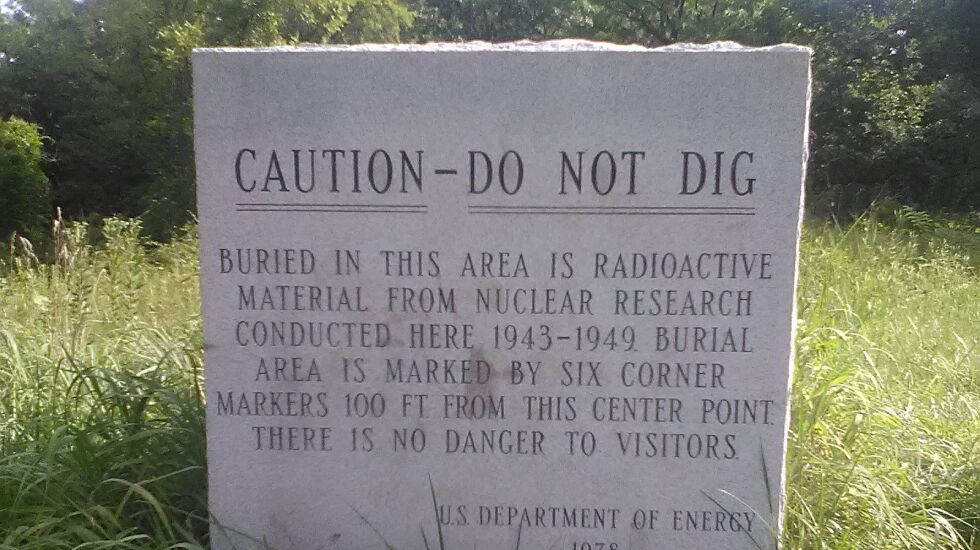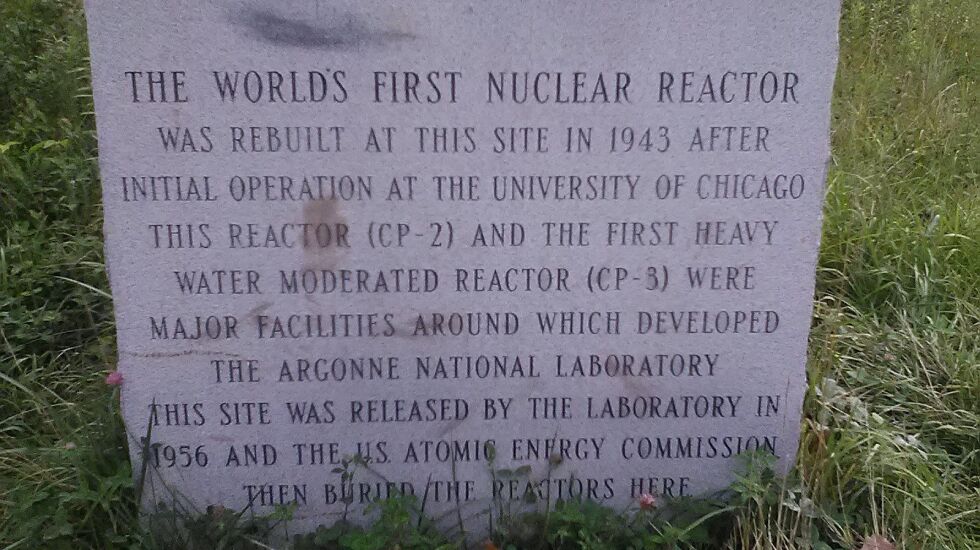
I have a deep affinity for what is green. Whenever possible, I slip away from gray concrete and head to the nearest patch of woods to watch, listen, and sometimes forage for wild edibles. I have more than a shadow of doubt regarding mushrooms.
A few years back, I decided to hike Red Gate Woods out in Chicago’s southwest suburbs. Although I had passed it several times, I had yet to explore it. Situated between Archer Avenue and Wolf Road, it’s a large, often rugged, tract of woods. It whispered to me.
With a light pack, binoculars, water, and several candy bars, I trudged along unfamiliar trails on a sunny, late-summer day. Amid the green, I discovered a squat, square, stone marker. It was about four feet high, gray, and each of its four sides was about three feet wide. Set about 50 yards off the trail I had been on, it was surrounded by wildflowers in fading bloom. No trees grew near it.
Cut into the trail-facing side of the marker were words stating that the radioactive remains of CP-1 — Chicago Pile-1, the reactor that had been built beneath Stagg Field at the University of Chicago and that produced, in 1942, the first controlled nuclear chain reaction — were buried there. The knowledge gained fueled the Manhattan Project.
A week later, I hiked down different trails, and I found a second such marker. The inscription was, however, quite different. After the success at the University of Chicago, CP-1 had been disassembled and rebuilt at that spot, where it was used to conduct further atomic experiments. Deactivated in 1954, the reactor was again disassembled and buried at the other spot a few hundred yards north of where I stood.
As I stood there, names and dates whispered to me. Stagg Field. Chicago. 1942. Los Alamos. The Manhattan Project. Oppenheimer. 1945. Hiroshima. Nagasaki.
Director Christopher Nolan’s film “Oppenheimer” was released last month to much fanfare. I have yet to see Nolan’s take on J. Robert Oppenheimer, and probably won’t for some time. Too much hype, and Hollywood romanticizes everything.
Besides, I have a shadow of a doubt about what Nolan seems to have given only passing attention to — the actual use of the atomic bombs on Hiroshima and Nagasaki. The mushroom clouds over both cities, the several hundred thousand civilian deaths, and the poisonous radioactive fallout should have been emphasized, as they would have added gravitas to Oppie’s life and legacy.
Those two historical markers had a profound effect upon me. We live in a dangerous world, and as our enemies — Russia, China, North Korea — are “nuked up,” we also, unfortunately, need such weapons for deterrence. Quite a dilemma.
In past decades, though, we engaged in high-level negotiations with, at least, the-then Soviet Union in limiting our nuclear stockpiles. Recall the Strategic Arms Limitation Talks (SALT) of the ‘60s and ‘70s, and the Strategic Arms Reduction Talks (START) of the ’80s and ‘90s. Now, a U.S. proposal for nuclear arms talks with Russia is in limbo. The United Nations is pushing nuclear disarmament talks, but how far will the efforts go?

In addition, we face another nuclear dilemma regarding energy production and consumption. Our appetite for electricity seems to be insatiable, for everything from our phones, computers, and more and more, for our vehicles. Where will the electricity come from? Wind, solar, biomass, coal? Or will our needs push us further towards embracing nuclear power?
Both nuclear weapons and energy production have something in common: They both produce radioactive waste that, no matter where it is stored, will remain radioactive for thousands of years, a poisonous legacy to leave for future generations.
Like those two gray stone markers in the woods, America has two nuclear dilemmas. They aren’t distantly historical or the stuff of Hollywood. Like the remains of CP-1, they seem to be buried under the collective weight of other current issues, from Donald Trump’s legal problems to abortion rights, and from LGBTQ+ rights to critical race theory.
But those issues pale in comparison to nuclear war and nuclear waste storage, both of which could threaten the very existence of humanity.
When I left the woods after that second hike, I wondered if those markers were also cenotaphs.
John Vukmirovich is a Chicago-area writer and book reviewer.
The Sun-Times welcomes letters to the editor and op-eds. See our guidelines.
The views and opinions expressed by contributors are their own and do not necessarily reflect those of the Chicago Sun-Times or any of its affiliates.







